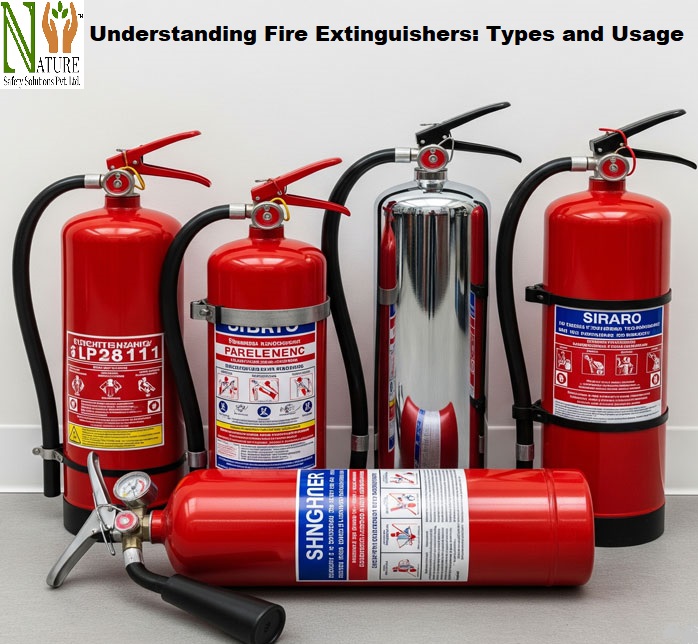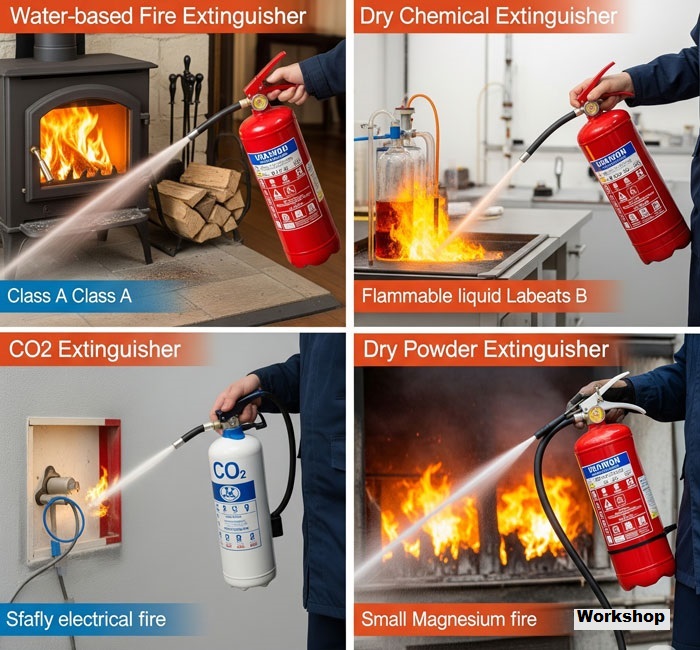Fire extinguishers are essential safety tools used to suppress fires and prevent them from spreading. Knowing the different types of fire extinguishers and how to use them effectively can save lives and property. This article provides a detailed guide on fire extinguisher types, their usage, and key safety considerations.
The Science of Fire: The Fire Triangle
To understand how fire extinguishers work, it’s important to grasp the concept of the “fire triangle,” which illustrates the three elements necessary for a fire to ignite and sustain itself:
Heat: The energy needed to raise the material to its ignition temperature.
Fuel: Any combustible material that can burn (wood, paper, liquids, gases).
Oxygen: The air that supports combustion.
Fire extinguishers work by removing or disrupting one or more of these elements, thereby breaking the fire triangle and extinguishing the fire.

Types of Fire Extinguishers
Fire extinguishers are classified based on the types of fires they are designed to combat. The classification system follows five primary categories:
1. Class A Fire Extinguishers (Ordinary Combustibles)
- Used for: Fires involving paper, wood, cloth, and other common materials.
- Extinguishing agent: Water or foam.
- Best usage: Aim at the base of the fire and sweep side to side.
2. Class B Fire Extinguishers (Flammable Liquids)
- Used for: Fires caused by gasoline, oil, paint, and other flammable liquids.
- Extinguishing agent: Carbon dioxide (CO₂), dry chemical, or foam.
- Best usage: Prevent splashing by applying the extinguisher gently over the burning liquid.
3. Class C Fire Extinguishers (Electrical Fires)
- Used for: Fires involving electrical equipment like circuits, wiring, and appliances.
- Extinguishing agent: Carbon dioxide (CO₂) or dry chemical.
- Best usage: Ensure the power source is off before extinguishing; do not use water.
4. Class D Fire Extinguishers (Metal Fires)
- Used for: Fires involving combustible metals like magnesium, titanium, or sodium.
- Extinguishing agent: Special dry powders designed to cool and smother metal fires.
- Best usage: Directly apply powder without disturbing the burning material.
5. Class K Fire Extinguishers (Kitchen Fires)
- Used for: Fires caused by cooking oils and grease in kitchens.
- Extinguishing agent: Wet chemical, which cools the fire and prevents re-ignition.
- Best usage: Apply slowly to smother the flames without causing splash-back.
Types of Fire Extinguishers: Your Arsenal Against Flames
Different types of fire extinguishers are designed to combat specific classes of fires. Here’s a breakdown of the most common types:
1. Water Extinguishers (APW – Air-Pressurized Water)
- Agent: Water
- Mechanism: Cools the fuel below its ignition temperature, removing the heat element of the fire triangle.
- Suitable for: Class A fires only.
- Not suitable for: Class B (can spread flammable liquids), Class C (electrocution hazard), Class D (violent reaction), Class K (can spread burning oil).
- Appearance: Typically red with a large “Water” label.
- Use: Often found in offices, schools, and public buildings for ordinary combustibles.
2. Foam Extinguishers (AFFF – Aqueous Film-Forming Foam)
- Agent: A mixture of water and foam concentrate.
- Mechanism: Creates a barrier (blanket) over the burning liquid, cutting off the oxygen supply and cooling the fuel.
- Suitable for: Class A and Class B fires.
- Not suitable for: Class C (can conduct electricity), Class D, Class K.
- Appearance: Typically red with a cream-colored band and “Foam” label.
- Use: Common in areas where flammable liquids are present, such as garages, workshops, and chemical storage areas.
3. Dry Chemical Extinguishers
These are the most common and versatile type of extinguishers, using a fine powder as the extinguishing agent.
Types:
- Standard Dry Chemical (BC): Uses sodium bicarbonate or potassium bicarbonate.
- Mechanism: Interrupts the chemical reaction of the fire.
- Suitable for: Class B and Class C fires.
- Not suitable for: Class A (no cooling effect), Class D, Class K.
- Appearance: Red with a black band and “BC” label.
- Use: Widely used in homes, vehicles, and commercial settings.
- Multi-Purpose Dry Chemical (ABC): Uses monoammonium phosphate.
- Mechanism: Forms a sticky residue that smothers and cools Class A fires; also interrupts the chemical reaction for Class B and C fires.
- Suitable for: Class A, Class B, and Class C fires.
- Not suitable for: Class D, Class K (can be somewhat effective on K but not ideal).
- Appearance: All red with an “ABC” label.
- Use: The most common type of extinguisher for general use in homes, offices, and vehicles due to its versatility.
4. Carbon Dioxide (CO2) Extinguishers
- Agent: Pressurized liquid carbon dioxide, which turns into a gas when discharged.
- Mechanism: Displaces oxygen, smothers the fire, and also provides a cooling effect.
- Suitable for: Class B and Class C fires.
- Not suitable for: Class A (no sustained cooling, fire can re-ignite), Class D (violent reaction with some metals), Class K.
- Appearance: Red with a black horn-shaped nozzle and “CO2” label. Often heavier than other extinguishers of similar size.
- Use: Ideal for sensitive electronic equipment because it leaves no residue. Common in server rooms, laboratories, and electrical panels.
5. Wet Chemical Extinguishers
- Agent: A potassium acetate-based solution.
- Mechanism: Creates a saponification (soap-like) effect that forms a foam blanket over the cooking oil, cutting off oxygen and cooling the oil.
- Suitable for: Class K fires. Also effective on Class A fires (due to water content).
- Not suitable for: Class B, C, D.
- Appearance: Red with a yellow band and “Wet Chemical” or “Class K” label.
- Use: Specifically designed for commercial kitchens, restaurants, and anywhere large quantities of cooking oils are used.
6. Clean Agent Extinguishers (Halotron, FM-200, Novec 1230)
- Agent: Non-conductive, non-corrosive gaseous agents.
- Mechanism: Interrupts the chemical reaction of the fire and provides some cooling. Leaves no residue.
- Suitable for: Class B and Class C fires. Some are also rated for Class A.
- Not suitable for: Class D.
- Appearance: Varies, but often similar to CO2 extinguishers or smaller pressurized cylinders.
- Use: Used in areas with sensitive electronic equipment, archives, data centers, and telecommunications facilities where minimizing damage from extinguishing agents is critical.
7. Dry Powder Extinguishers (Class D Specific)
- Agent: Various dry powders specifically formulated for different combustible metals (e.g., sodium chloride, graphite, copper-based powders).
- Mechanism: Smothers the fire and forms a crust that prevents re-ignition, also absorbs heat.
- Suitable for: Class D fires only.
- Not suitable for: Class A, B, C, K (can actually worsen these fires).
- Appearance: Typically yellow with a “Class D” label. Often has a specialized applicator wand.
- Use: Found in industrial settings where combustible metals are used, such as laboratories, metalworking facilities, and aircraft manufacturing.

How to Use a Fire Extinguisher: The PASS Method
Once you’ve identified the correct type of extinguisher for the fire, knowing how to use it safely and effectively is paramount. Remember the acronym PASS:
- P – Pull the Pin: Break the tamper seal and pull the pin, which unlocks the operating lever.
- A – Aim the Nozzle: Aim the nozzle or hose at the base of the fire, not at the flames themselves. Targeting the base extinguishes the fuel source.
- S – Squeeze the Handle: Squeeze the operating handle to release the extinguishing agent.
- S – Sweep from Side to Side: Sweep the nozzle from side to side, covering the entire area of the fire’s base. Continue until the fire appears to be out.
Important Usage Tips:
- Stand at a Safe Distance: Typically 6-8 feet (1.8-2.4 meters) from the fire, adjusting closer as the fire diminishes.
- Always Have an Escape Route: Ensure you have a clear path to safety behind you.
- Never Turn Your Back on the Fire: Even if the fire appears out, watch for re-ignition.
- Evacuate if Necessary: If the fire is too large, spreading rapidly, or you are unsure, evacuate immediately and call emergency services. Do not attempt to fight a fire that is beyond your capabilities or if you feel unsafe.
- Check Pressure Gauge: Before using, quickly check the pressure gauge to ensure it’s in the green “charged” zone.
- Read Instructions: Familiarize yourself with the specific instructions on your extinguisher.
Maintenance and Inspection
Fire extinguishers are not “set it and forget it” devices. Regular inspection and maintenance are crucial to ensure they are ready for use when needed:
- Monthly Visual Inspection: Check the pressure gauge (if applicable) is in the green zone, the pin is intact, the nozzle is clear, and there are no signs of damage or tampering.
- Annual Professional Inspection: Fire extinguishers should be inspected annually by a qualified professional to ensure they are in proper working order and to perform any necessary maintenance or recharging.
- Hydrostatic Testing: Every 5-12 years (depending on the extinguisher type), the cylinder needs to be hydrostatically tested to ensure its structural integrity.
- Recharging: Any extinguisher that has been used, even partially, or has lost pressure, must be immediately recharged by a professional.
Also read:-
- Creating an Effective Fire Evacuation Plan: A Step-by-Step Guide
- Everything You Need to Know About an EHS Inspection
- Why Environmental Compliance Matters to Business
- OSHA’s New PPE Requirements for Construction: What You Need to Know Now
- Why Environment, Health & Safety Matters More Than Ever
- Benefits of Tree Plantation Drives at Workplaces
